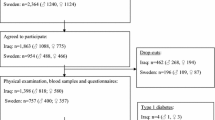Abstract
Numerous anthropological reports have indicated consanguineous marriage in populous Asian countries, but the overall impact of first cousin marriage on survival and health of specific communities has rarely been reported. The aim of the study was to estimate risks for various complex diseases in the progeny of consanguineous parents. A cross-sectional study was conducted among 222 women among Siddis, a particularly vulnerable tribal group in the state of Gujarat, India, who are Sunni Muslims by faith. The Siddis are not part of the original Negrito element of India. They are descendants of Africans from Northeast and East Africa who were brought to India as slaves, soldiers, or servants. The degree of consanguinity between each female and her spouse and the degree of consanguinity between their parents and proband’s grandparents were recorded with the help of pedigrees. The results showed that the rate of consanguinity in the present generation was 49 % (N = 109), higher than preceding generations. A significant association was observed between women’s age, educational level, occupational status, consanguineous parents, and consanguinity. Socioeconomic status and consanguinity showed U-shaped associations. Nearly three times odds for cardio-metabolic risks (2.65 odds ratio (OR) for heart diseases, 2.44 OR for diabetes mellitus, and 2.62 OR for hypertension) have been contracted in the progeny of consanguineous marriage in the parental generation. The risk of cardio-metabolic diseases is higher in offspring of consanguineous couples, and there is a significant increase in the prevalence of common adult diseases.
Similar content being viewed by others
Abbreviations
- SLI:
-
Standard of living index
References
Bener A, Hussain R, Teebi AS (2007) Consanguineous marriages and their effects on common adult diseases: studies from an endogamous population. Med Princ Pract 16(4):262–267
Bittles AH (1994) The role and significance of consanguinity as a demographic variable. Popul Dev Rev 20(3):561–584
Bittles A (2001) Consanguinity and its relevance to clinical genetics. Clin Genet 60(2):89–98
Bittles AH (2002) The impact of consanguinity on the Indian population. Indian J human Genet 8(2):45–51
Bittles AH, Black ML (2010) Consanguinity, human evolution, and complex diseases. Proc Natl Acad Sci 107(suppl 1):1779–1786
Bittles AH, Hussain R (2000) An analysis of consanguineous marriage in the Muslim population of India at regional and state levels. Ann Hum Biol 27(2):163–171
Bittles AH, Mason WM, Greene J, Rao NA (1991) Reproductive behavior and health in consanguineous marriages. Science 252(5007):789–794
Cavalli-Sforza L, Moroni A, Zei G (2004) Consanguinity, inbreeding, and genetic drift in Italy. Princeton Univ Press, Princeton
Davey Smith G, Gordon D, Kelly M, Nandy S, Subramanian S (2003) Inequalities in health in India: the methodological construction of indices and measures. UK Department for International Development
Hamamy H (2012) Consanguineous marriages: preconception consultation in primary health care settings. J Commun Genet 3(3):185–192
Imaizumi Y (1988) Parental consanguinity in two generations in Japan. J Biosoc Sci 20(02):235–243
Insilicase. In; 2011. http://www.insilicase.co.uk/
Modell B, Darr A (2002) Genetic counselling and customary consanguineous marriage. Nat Rev Genet 3(3):225–229
Mukherjee A (1973) Patterns of marriage and family formation in rural India and genetic implications of family planning. J Indian Anthrop Soc 8:131–145
Padmadas SSP, Nair PS (2001) Consanguineous unions and its effect on foetal and infant loss in India. Genus 57(3/4):83–105
Prakasam C, Prasad MB. Influence of environmental factors on child survival. Age 15:19
Rédei GP (2008) Encyclopedia of genetics, genomics, proteomics, and informatics. Springer
Shah Anish M, Tamang R, Moorjani P, Rani Deepa S, Govindaraj P, Kulkarni G et al (2011) Indian Siddis: African descendants with Indian admixture. Am J Hum Genet 89(1):154–161
Subramanian SV, Davey Smith G, Subramanyam M (2006) Indigenous health and socioeconomic status in India. PLoS Med 3(10):e421
Acknowledgments
The authors are grateful to all the subjects for their cooperation. Financial assistance to PB in the form of a fellowship (UGC) is greatly acknowledged. All the help received from government officials of Junagadh district, Gujarat, India; ASHA workers; and medical professionals deserves acknowledgement.
Compliance with ethics guidelines
The experiments performed in this study comply with the current laws of the country in which they were performed.
Author information
Authors and Affiliations
Corresponding author
Rights and permissions
About this article
Cite this article
Bhasin, P., Kapoor, S. Impact of consanguinity on cardio-metabolic health and other diseases: findings from an Afro-Indian tribal community. J Community Genet 6, 129–135 (2015). https://doi.org/10.1007/s12687-014-0207-z
Received:
Accepted:
Published:
Issue Date:
DOI: https://doi.org/10.1007/s12687-014-0207-z




